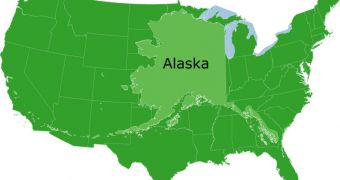Geologists were recently able to confirm older hypothesis saying that, millennia ago, a large portion of what is now Alaska was inundated with massive amounts of water. The researchers determined that a massive flood took place at an area covering the Copper River Basin northeast of Anchorage, no more than 17,000 years ago. The deluge was so massive, that it covered some 3,500 square miles (9,065 square kilometers) of land. The most likely origin for the devastation was the ancient Glacial Lake Atna, which is well known for having produced three other such floods in the past.
When the flood occurred, the sheer strength of the water broke ice dams and other natural obstacles that were protecting the flooded region, and covered a region three times larger than the state of Rhode Island. Available data seem to confirm that this was one of the most devastating natural disasters of this type to have ever occurred on Earth. Scientists mention that, by definition, a megaflood spews at least 264 million gallons (999,348,716 liters) of water. The Glacial Lake Missoula, based in Montana, currently holds the record for the largest flood ever recorded, at 4,500 million gallons of water spewed.
It is estimated that the recently-confirmed flood spewed around 792 million gallons of water in the surrounding region, and that it dislodged a total of about 336 cubic miles (1,400 cubic kilometers) of water from its initial location. This amount is sufficiently large to cover Washington DC under 8 kilometers of liquid. Details of how experts believe the event took place appear in the latest issue of the esteemed scientific journal Quaternary Research. The first indicative signs of the flood were found by University of Washington in Seattle graduate student Michael Wiedmer.
The scientist found pygmy whitefish living in a lake that had been drained so many times, it was a wonder anything lived within. Careful analysis of the animal revealed that it exhibited strong similarities to fish living in three other mountain lakes, all of which were remnants of Lake Atna. According to Wiedmer, “Lake Atna linked up with four distinct drainages, and we think that helped it act like a pump for freshwater organisms.” This may indeed account for the distribution of this fish species, he adds.
Additional evidence found nearby hint at the interesting possibility that another megaflood may have taken place in the area. Signs of two additional, smaller floods were also found, and the scientist says that he plans to investigate how they evolved later on, LiveScience reports.

 14 DAY TRIAL //
14 DAY TRIAL //